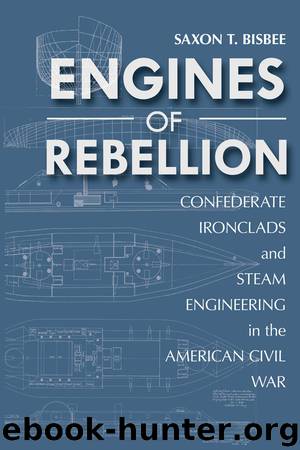Engines of Rebellion by Saxon Bisbee

Author:Saxon Bisbee
Language: eng
Format: epub
ISBN: 9780817391881
Publisher: University of Alabama Press
CSS Charleston
The third ironclad built at Charleston, South Carolina, was named in honor of that city. CSS Charleston was built by the firm of J. M. Eason & Brother, which began construction in December 1862.2 This ironclad was the first one built to Graves’s design and is notable chiefly for its flat floors and soft bilge turns, compared to Porter’s vessels, as well as an unusually long protruding ram. The latter feature was the Graves ironclads’ most distinguishing feature, but its design remains mysterious. Possibly it was intended for use against monitors, whose armored rafts protected their hulls much as the knuckles of Confederate ironclads protected theirs. The long extension and curved upper surface of the Graves ram may have been intended to slip under the raft and strike a monitor’s unprotected hull.3
Previous wartime experiences of ramming may also have been kept in mind. The Graves ram’s somewhat fragile shape, with a thickness of only one foot, could have been designed to break off after insertion. The Virginia’s experience after ramming USS Cumberland, when only the breaking of the ram prevented the Virginia from being dragged to the bottom, clearly demonstrated the danger if the weapon was not quickly withdrawn.4
Although both hypotheses are plausible, neither the Charleston nor the Virginia II ever had the chance to ram an enemy vessel. Their design (at least as Graves originally conceived it) was otherwise fairly standard. This is known through the preservation of two half-hull models in the US Naval Academy Collection at the Smithsonian Institution.5
As with most Confederate ironclads, changes were made to the Charleston during construction. The ship was modified to carry two pilothouses (one forward and one aft), and the casemate was changed to a simpler four-sided layout instead of the original octagonal. In addition, the upper bow was modified for carrying a spar torpedo. The end product was a large ironclad measuring 180 feet long between perpendiculars, 201 feet long overall, 44 feet in extreme beam, 14 feet in depth of hold, and a little more than 12 feet in draft.6
The Charleston was finished in early 1863 and commissioned on August 19 of that year. A single 9-feet-in-diameter screw powered by one or two direct-acting low-pressure engines pushed the Charleston along at approximately 6 miles per hour. Nothing is known about the boilers. All the information presented here comes from an August 1863 entry in the John Horry Dent Papers, a restricted collection kept by the University of Alabama. No other information on the Charleston’s machinery or its source has been found. It is possible that the shipbuilder, the Eason foundry, manufactured it, since that establishment certainly had the experience and the capability.
Isaac Newton Brown of CSS Arkansas fame became the Charleston’s commander, but by the time the ship was commissioned the major local naval events in which ironclads participated were over. The Chicora and the Palmetto State’s dramatic but ineffective raid had occurred almost half a year earlier, and the one major federal assault on Charleston Harbor by water ended in repulse by the Confederate forts.
Download
This site does not store any files on its server. We only index and link to content provided by other sites. Please contact the content providers to delete copyright contents if any and email us, we'll remove relevant links or contents immediately.
| Africa | Americas |
| Arctic & Antarctica | Asia |
| Australia & Oceania | Europe |
| Middle East | Russia |
| United States | World |
| Ancient Civilizations | Military |
| Historical Study & Educational Resources |
Cat's cradle by Kurt Vonnegut(14758)
Pimp by Iceberg Slim(13777)
Underground: A Human History of the Worlds Beneath Our Feet by Will Hunt(11836)
4 3 2 1: A Novel by Paul Auster(11788)
The Radium Girls by Kate Moore(11621)
Wiseguy by Nicholas Pileggi(5316)
American History Stories, Volume III (Yesterday's Classics) by Pratt Mara L(5133)
Perfect Rhythm by Jae(5070)
The Fire Next Time by James Baldwin(5016)
Paper Towns by Green John(4796)
Pale Blue Dot by Carl Sagan(4613)
A Higher Loyalty: Truth, Lies, and Leadership by James Comey(4550)
The Mayflower and the Pilgrims' New World by Nathaniel Philbrick(4278)
The Doomsday Machine by Daniel Ellsberg(4245)
Killers of the Flower Moon: The Osage Murders and the Birth of the FBI by David Grann(4188)
The Sympathizer by Viet Thanh Nguyen(4093)
Too Much and Not the Mood by Durga Chew-Bose(4091)
The Borden Murders by Sarah Miller(4014)
Sticky Fingers by Joe Hagan(3911)
